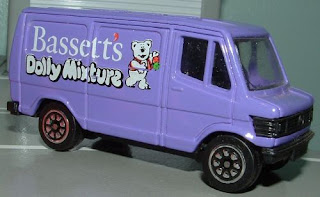A blog focusing on 1/64 diecast from such popular brands as Hot Wheels, Matchbox, Johnny Lightning, M2 Machines, GreenLight, Tomica, Yat Ming, Majorette, MotorMax, Siku, Corgi, Guisval, Playart, Ertl, Zylmex, Racing Champions, & many more. Swifty's Garage features a daily Car Of The Day and news updates from your favorite brands!
Friday, January 13, 2012
Van Of The Day: January 12, 2012 (Belated)
Today's car of the day is Welly's 1983 Mercedes-Benz T1.
In 1977 Mercedes-Benz introduced a new van/truck (a.k.a. transporter), called T1 internally. Other designations were series TN and Bremen Transporter, since the vehicle was built in a factory near Bremen, Germany. The T1 was a durable vehicle, available as a minibus or fitted with a cargo box body or flat cargo bed. A double cab version was offered in the latter two configurations. Three wheel bases were available, with gross weight ratings ranging from 2.55 to 4.6 tonnes. Mercedes-Benz-built gasoline or diesel engines were available as powerplant options for the rear-wheel drive chassis. The T1 van was also used as a campervan conversion, being somewhat larger than the Volkswagen Transporter. Its closest European competitors were the Volkswagen LT and the Ford Transit. In 1995, after 18 years of production, the TN/T1 van series was discontinued, succeeded by the T1N "Sprinter".
For more information and pictures of the real car please visit: Mercedes-Benz T1
This is a recent purchase from Pegers (thanks Dan!). This is very likely a copy of a Siku.
Market share was almost 90% for the Diesel engine and a little more than 10% for the petrol engine. While the petrol engine was mainly used for ambulances which needed the extra power, commercial buyers preferred the Diesel engine for its lower fuel consumption. The body styles were panel van, window van, pickup and pickup with double cab. Power outputs for the 4 cylinder engines were quite low, a result of the underpowered/over engineered style of engine design, which made for a leisurely driving experience, however the upshot of this was an engine that could potentially outlive the body of the van, so unstressed were they. Low gearing also meant that the vans were capable pullers, able to make best use of the power available whilst returning surprisingly good fuel economy for the large size of vehicle.
In September 1981 the 407 D and 409 D were added with a gross weight of 4,600 kg (10,141 lb). The 409 D had a bigger and more powerful Diesel engine with five cylinders, 3005 cc and 88 hp (65 kW), It was the OM 617 engine which was also used in the Mercedes-Benz 300D passenger car. Other revisions throughout the vans production were minor, the OM616 engine having a modified cylinder head which lowered the capacity from 2404 cc to 2399 cc, but producing slightly more power (72 bhp) and then later on to 2304 cc, producing 78 bhp (58 kW) and the van thus redesignated as 208D, 308D and 408D. The 5 cylinder variant was also changed from 3005 cc to 2898 cc, again producing slightly more power and the models re-designated 210D, 310D and 410D.
Subscribe to:
Post Comments (Atom)






No comments:
Post a Comment